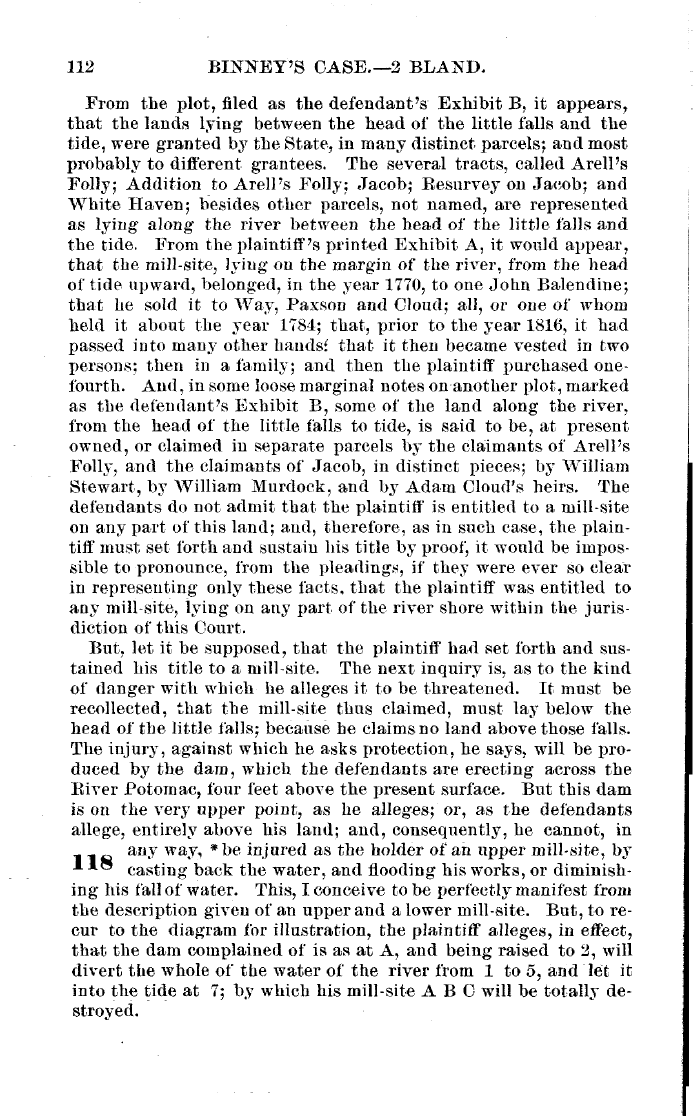|
112 BINNEY'S CASE.-2 BLAND.
From the plot, filed as the defendant's Exhibit B, it appears,
that the lands lying between the head of the little falls and the
tide, were granted by the State., in many distinct parcels; and most
probably to different. grantees. The several tracts, called Arell's
Folly; Addition to Arell's Folly; Jacob; Resurvey on Jacob; and
White Haven; besides other parcels, not named, are represented
as lying along the river between the head of the little. falls and
the tide. Front the plaintiff's printed Exhibit A, it would appear,
that the mill-site, lying ou the margin of the river, from the head
of tide upward, belonged, in the year 1770, to one John Balendine;
that lie sold it to Way, Paxson and Cloud; all, or one of whom
held it about the year 1784; that, prior to the year 1816, it had
passed into many other bandsf that it then became vested in two
persons; then in a family; and then the plaintiff' purchased one-
fourth. And, in some loose marginal notes on another plot, marked
as the def'endant's Exhibit B, some of the land along the river,
from the head of the little falls to tide, is said to be, at present
owned, or claimed in separate parcels by the claimants of Arell's
Folly, and the claimants of Jacob, in distinct pieces; by William
Stew art, by William Murdock, and by Adam Cloud's heirs. The
defendants do not admit that the plaintiff is entitled to a mill-site
on any part of this land; and, therefore, as in such case, the plain-
tiff must set forth and sustain his title by proof; it would be impos-
sible to pronounce, from the pleading, if' they were ever so clear
in representing only these facts, that the plaintiff was entitled to
any mill-site, lying on any part of the, river shore within the juris-
diction of this Court.
But, let it be supposed, that the plaintiff bad set forth and sus-
tained his title to a mill-site. The next inquiry is, as to the kind
of danger with which lie alleges it to be threatened. It must be
recollected, that the mill-site thus claimed, must lay below the
head of the little falls; because be claims no land above those falls.
The injury, against which he asks protection, he says, will be pro-
duced by the dam, which the defendants are erecting across the
River Potomac, four feet above the present surface. But this dam
is on the very upper point, as he alleges; or, as the defendants
allege, entirely above his land; and, consequently, he cannot, in
any way, *be injured as the holder of an upper mill-site, by
118 casting back the water, and flooding his works, or diminish-
ing his fall of water. This, 1 conceive to be perfectly manifest front
the description given of an upper and a lower mill-site. But, to re-
cur to the diagram for illustration, the plaintiff alleges, in effect,
that the dam complained of is as at A, and being raised to 2, will
divert the whole of the water of the river from 1 to 5, and -let it
into the tide at 7; by- which his mill-site A B C will be totally de-
stroyed.
|

